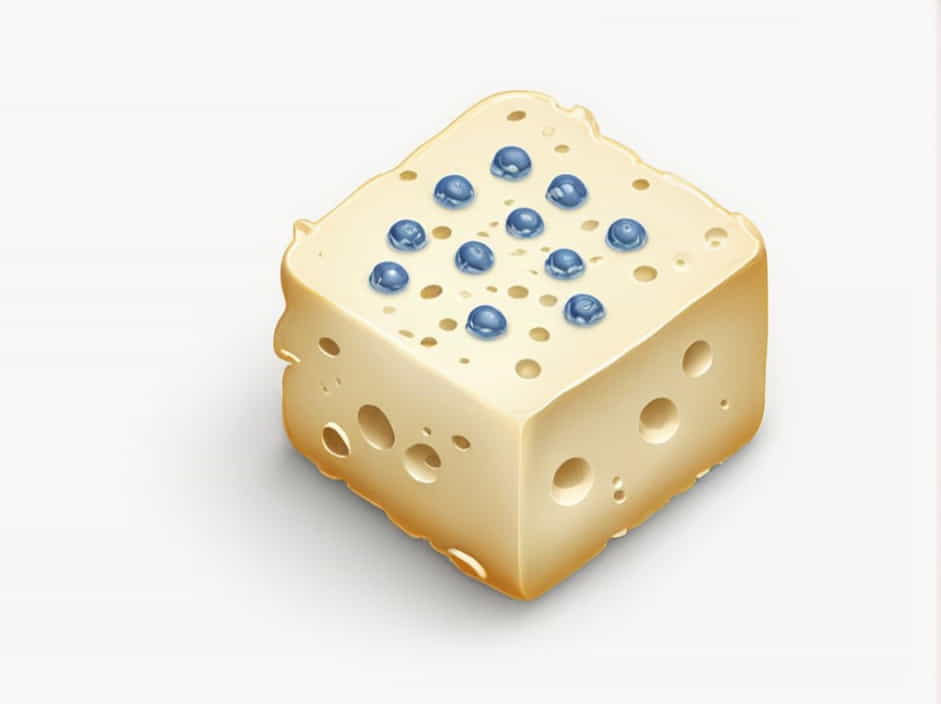Roquefort cheese is one of the most famous blue cheeses in the world, known for its distinct flavor, creamy texture, and blue veins of mold. It is often called the “King of Cheesesâ due to its rich history and unique production process.
But what makes Roquefort cheese so special? The answer lies in its ripening process, which is driven by a specific mold: Penicillium roqueforti. This mold is responsible for the cheese’s signature blue-green marbling, sharp taste, and creamy consistency.
In this topic, we’ll explore how Roquefort cheese is ripened by Penicillium roqueforti, the traditional production methods, and why this mold is essential for its distinct characteristics.
What Is Roquefort Cheese?
A Traditional French Cheese
Roquefort is a French blue cheese made from the milk of Lacaune sheep. It is exclusively produced in the Roquefort-sur-Soulzon region of France, where the unique aging process takes place.
This cheese is protected under the AOC (Appellation d’Origine Contrà´lée) and PDO (Protected Designation of Origin) certifications, ensuring that only cheese made in this region, following strict guidelines, can be called Roquefort.
Appearance and Flavor
-
Texture: Creamy yet crumbly
-
Color: White with distinctive blue-green veins
-
Flavor: Sharp, tangy, and slightly salty with a rich, earthy aroma
The secret behind these characteristics is Penicillium roqueforti, a mold that develops inside the cheese during the aging process.
How Is Roquefort Cheese Ripened?
The Role of Penicillium Roqueforti
The ripening of Roquefort cheese depends on Penicillium roqueforti, a mold that thrives in the natural limestone caves of Roquefort-sur-Soulzon. This mold plays a crucial role in:
-
Creating the blue-green veins
-
Developing the cheese’s distinct flavor
-
Aiding the breakdown of fats and proteins, giving Roquefort its creamy consistency
The Aging Process
The production and ripening of Roquefort cheese follow a carefully controlled process:
1. Cheese Production and Curd Formation
-
Fresh Lacaune sheep’s milk is collected and curdled using rennet.
-
The curds are cut, drained, and pressed to form the cheese’s basic shape.
2. Adding Penicillium Roqueforti
-
Before aging, Penicillium roqueforti spores are added to the cheese.
-
The mold can be introduced by mixing it with the milk or by sprinkling it over the curds.
3. Piercing the Cheese
-
The cheese wheels are pierced with needles, allowing oxygen to enter.
-
This oxygen is essential for Penicillium roqueforti to grow and form blue veins inside the cheese.
4. Aging in Natural Caves
-
The cheese is placed in limestone caves of Roquefort-sur-Soulzon.
-
These caves have cool temperatures and high humidity, creating the perfect conditions for mold development.
-
Over three to six months, the cheese matures, and Penicillium roqueforti transforms its texture and flavor.
The Importance of Penicillium Roqueforti in Roquefort Cheese
1. Creates the Blue Veins
Without Penicillium roqueforti, Roquefort cheese would not have its signature blue-green marbling. The mold spreads inside the cheese, forming veins that are essential for its appearance and taste.
2. Develops the Strong, Tangy Flavor
As the mold grows, it breaks down proteins and fats, releasing compounds that create Roquefort’s sharp, tangy, and slightly spicy flavor.
3. Enhances the Creamy Texture
The mold also plays a role in softening the cheese, making it creamy yet crumbly. This allows Roquefort to melt beautifully on the tongue.
4. Prevents Harmful Bacteria
Penicillium roqueforti has natural antibacterial properties, which help prevent the growth of harmful bacteria while allowing the cheese to ripen safely.
How Roquefort Cheese Compares to Other Blue Cheeses
Roquefort is not the only blue cheese made with Penicillium roqueforti, but it has distinct differences from other varieties.
| Cheese | Milk Type | Aging Location | Flavor Profile |
|---|---|---|---|
| Roquefort | Sheep’s milk | Limestone caves in Roquefort, France | Strong, tangy, creamy |
| Gorgonzola | Cow’s milk | Italy | Milder, slightly sweet |
| Stilton | Cow’s milk | England | Nutty, rich, firm texture |
| Danish Blue | Cow’s milk | Denmark | Salty, creamy, slightly bitter |
The exclusive use of Lacaune sheep’s milk and aging in natural caves make Roquefort stand out among other blue cheeses.
Pairing Roquefort Cheese for the Best Experience
1. Wines That Complement Roquefort
Roquefort pairs well with sweet and full-bodied wines, balancing its salty and tangy flavors. Some excellent choices include:
-
Sauternes (a sweet French wine)
-
Port wine
-
Chardonnay
-
Cabernet Sauvignon
2. Best Foods to Serve With Roquefort
Roquefort cheese enhances many dishes, including:
-
Fresh fruit (pears, apples, figs, grapes)
-
Nuts (walnuts, almonds)
-
Crusty bread and crackers
-
Salads with honey or balsamic dressing
-
Steaks and burgers for a rich topping
3. Cooking with Roquefort
Roquefort is often used in:
-
Salad dressings
-
Sauces for steak and pasta
-
Blue cheese butter for grilled meats
-
Gourmet sandwiches and burgers
Health Benefits of Roquefort Cheese
Despite its rich and creamy texture, Roquefort cheese offers several health benefits:
1. Rich in Calcium and Protein
- Supports bone health and muscle development.
2. Contains Healthy Fats
- Good fats from sheep’s milk contribute to heart and brain health.
3. Supports Gut Health
- The natural mold and fermentation process promote gut-friendly bacteria.
4. High in Antioxidants
- Penicillium roqueforti contains compounds that reduce inflammation and may support heart health.
Roquefort cheese is a true masterpiece of French cheesemaking, and its ripening process is what makes it so special. Thanks to Penicillium roqueforti, this cheese develops its signature blue veins, tangy flavor, and creamy texture.
From its strict production in Roquefort-sur-Soulzon to its unique aging in limestone caves, every step contributes to its world-class reputation. Whether enjoyed on its own, in a dish, or paired with wine, Roquefort remains one of the most iconic blue cheeses in the world.
Next time you try Roquefort, rememberâit’s the magic of Penicillium roqueforti that makes it truly unforgettable!
